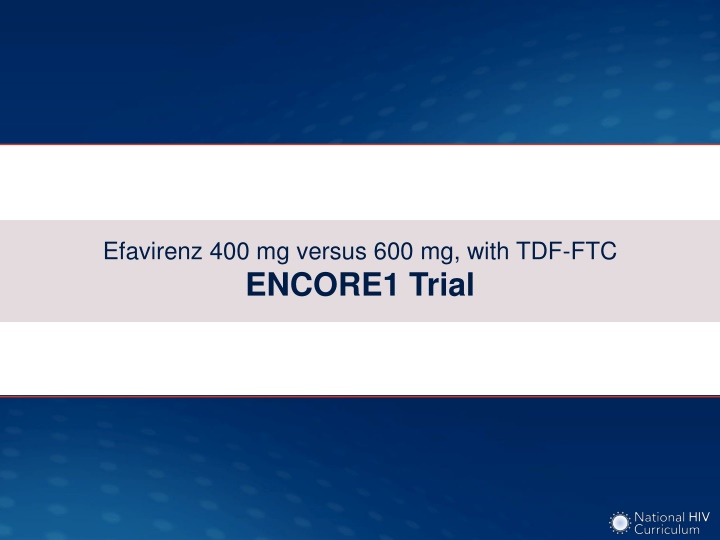
Reduced Dose Efavirenz 400mg vs. Standard Dose 600mg in HIV Treatment
"Comparison of Efavirenz at 400mg vs. 600mg doses in combination with TDF-FTC for HIV treatment in ART-naive adults. Results show non-inferiority of 400mg dose with fewer adverse events. Study details and conclusions from ENCORE1 trial."
Download Presentation

Please find below an Image/Link to download the presentation.
The content on the website is provided AS IS for your information and personal use only. It may not be sold, licensed, or shared on other websites without obtaining consent from the author. If you encounter any issues during the download, it is possible that the publisher has removed the file from their server.
You are allowed to download the files provided on this website for personal or commercial use, subject to the condition that they are used lawfully. All files are the property of their respective owners.
The content on the website is provided AS IS for your information and personal use only. It may not be sold, licensed, or shared on other websites without obtaining consent from the author.
E N D
Presentation Transcript
Efavirenz 400 mg versus 600 mg, with TDF-FTC ENCORE1 Trial
Efavirenz 400 mg versus Efavirenz 600 mg, with TDF-FTC ENCORE1: Study Design Study Design: ENCORE1 Background: Randomized, double-blind, placebo- controlled study comparing the safety and efficacy of two doses of efavirenz, in combination with co- formulated tenofovir DF and emtricitabine Efavirenz 400 mg + TDF-FTC QD (n = 321) Inclusion Criteria (n = 636) - Antiretroviral-na ve - Age 16 years - HIV RNA 1000 copies/mL - CD4 count >50 and <500 cells/mm3 Efavirenz 600 mg + TDF-FTC QD (n = 309) Treatment Arms - Efavirenz 400 mg QD + TDF-FTC QD - Efavirenz 600 mg QD + TDF-FTC QD Source: ENCORE1 Study Group. Lancet. 2014;383:1474-82.
Efavirenz 400 mg versus Efavirenz 600 mg, with TDF-FTC ENCORE1: Results Week 48: Virologic Response (Modified Intention-to-Treat) Efavirenz 400 mg + TDF-FTC Efavirenz 600 mg + TDF-FTC 100 94.1 92.2 86.0 80 84.1 Patients (%) 60 40 20 302/321 285/309 276/321 260/309 0 <200 copies/mL <50 copies/mL HIV RNA Threshold Source: ENCORE1 Study Group. Lancet. 2014;383:1474-82.
Efavirenz 400 mg versus Efavirenz 600 mg, with TDF-FTC ENCORE1: Results Overall Adverse Events EFV 400 mg n (%) EFV 600 mg n (%) Variable 1173 (49.8%) 1182 (50.2%) Number of adverse events Serious adverse events Total number of serious adverse events 31 (46.2%) 36 (53.7%) Number with serious adverse events 23 (7.17%) 22 (7.12%) Number with serious adverse events related to study drug 3 (0.93%) 4 (1.29%) Adverse events probably related to study drug Patients with adverse events related to study drug Patients stopping drug due to drug related adverse event 118 (36.8%) 146 (47.2%) 6 (1.9%) 18 (5.8%) Source: ENCORE1 Study Group. Lancet. 2014;383:1474-82.
Efavirenz 400 mg versus Efavirenz 600 mg, with TDF-FTC ENCORE1: Conclusions Interpretation: Our findings suggest that a reduced dose of 400 mg efavirenz is non-inferior to the standard dose of 600 mg, when combined with tenofovir and emtricitabine during 48 weeks in ART-naive adults with HIV-1 infection. Adverse events related to the study drug were more frequent with 600 mg efavirenz than with 400 mg. Lower dose efavirenz should be recommended as part of routine care. Source: ENCORE1 Study Group. Lancet. 2014;383:1474-82.
Acknowledgment The National HIV Curriculum is an AIDS Education and Training Center (AETC) Program supported by the Health Resources and Services Administration (HRSA) of the U.S. Department of Health and Human Services (HHS) as part of an award totaling $800,000 with 0% financed with non-governmental sources. This project is led by the University of Washington s Infectious Diseases Education and Assessment (IDEA) Program. The content in this presentation are those of the author(s) and do not necessarily represent the official views of, nor an endorsement, by HRSA, HHS, or the U.S. Government.
